
On October 22, 2024, Deng Hongkui and Guan Jingyang's research team of Peking University collaborated to publish a research paper titled "Generation of Human Expandable Limb-Bud-like Progenerators via Chemically Induced Dedifferentiation" online in Cell Stem Cell magazine.
This study further proved that chemical reprogramming technology can induce Chemically induced dedifferentiation of human cells and successfully prepare large-scale expanded embryonic limb budd-like precursor cells. This innovative achievement utilizes the characteristics of small chemical molecules to accurately regulate cell fate, simulates the regenerative laws of lower animals, and opens up a new way for the preparation of human precursor cells with regenerative potential and large-scale expansion capabilities.
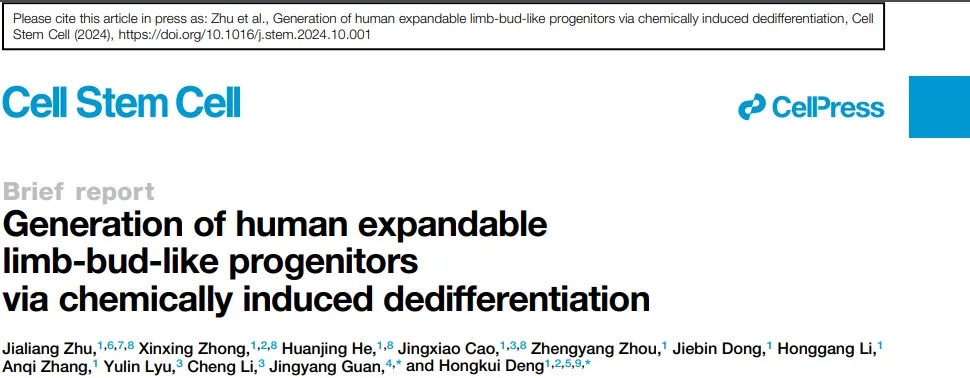
01 Chemical reprogramming technology
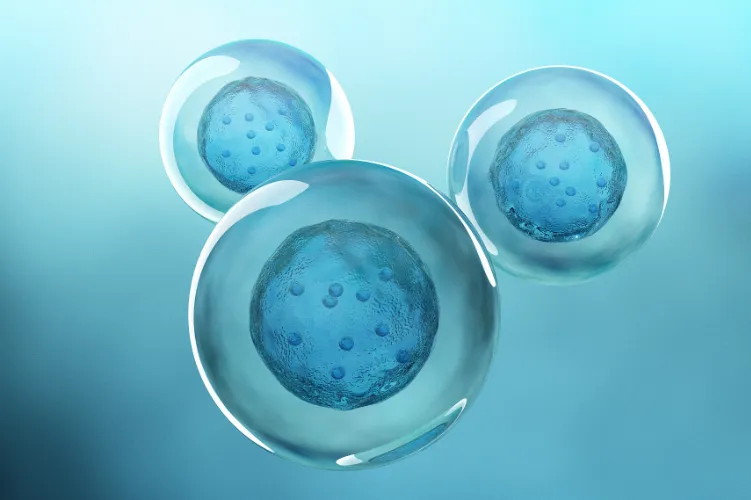
Deng Hongkui's team has been committed to the research of chemical reprogramming regulating cell fate for many years.
In 2013, it was first reported internationally that only small chemical molecules were used to reverse the cell development clock and reprogram mouse somatic cells into pluripotent stem cells. This original achievement opens up a new path for somatic cell reprogramming.
In 2022, the team realized for the first time a technical system that uses small chemical molecules to induce human cells to become pluripotent stem cells, providing a new way for the preparation of human pluripotent stem cells and is an important breakthrough in the underlying technology in the field of stem cells.
On this basis, a more rapid, efficient human cell chemical reprogramming system that meets the needs of clinical applications will be established in 2023.
Taking diabetes treatment as an entry point, the team demonstrated that chemically reprogrammed induced human pluripotent stem cells can efficiently differentiate into islet cells and significantly improve blood sugar control in diabetic monkeys.
What is even more exciting is that the team recently reported for the first time that islet cell transplantation prepared using chemically reprogrammed induced pluripotent stem cells, and the patient has initially achieved clinical functional cure of type 1 diabetes.
This series of research results proves the great potential and important application value of chemical reprogramming technology in the treatment of major diseases in the field of regenerative medicine.
At present, the team has also successfully differentiated human pluripotent stem cells induced by chemical reprogramming into functional cells such as liver cells and iTNK cells, demonstrating the broad application prospects of human chemical reprogramming.
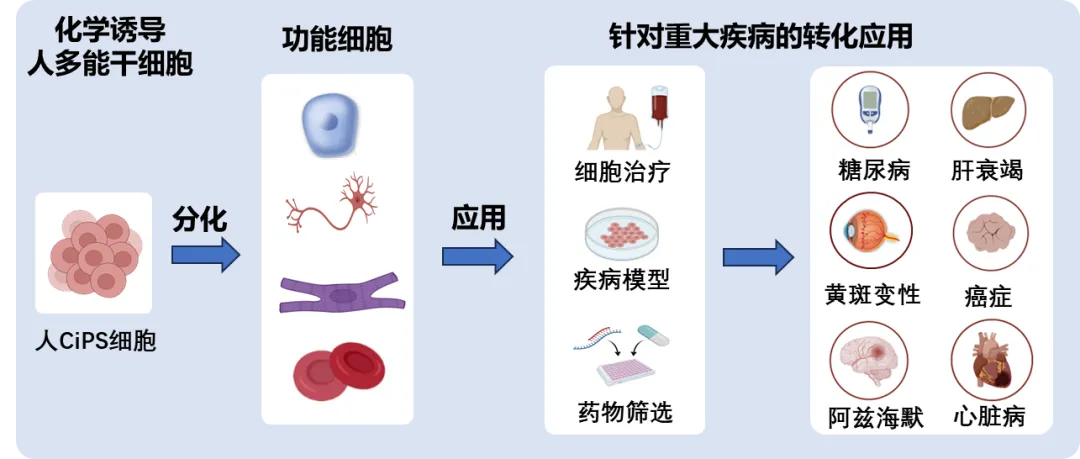
Chemical reprogramming induces broad application prospects of human pluripotent stem cells
Deng Hongkui's team's research found that there are essential differences between chemical reprogramming technology and traditional reprogramming technology. Traditional transgenic reprogramming technology relies on the over-expression of endogenous transcription factors in cells, directly driving the transformation of cell properties, making it difficult to achieve precise regulation of cell fate. Chemical reprogramming technology uses small chemical molecules to simulate external signal stimuli, similar to the principle of cell destiny regulation in natural development, and promotes the phased and orderly regulation of cell destiny in a more flexible and controllable way.
In a 2015 study, the team found that chemical reprogramming of mouse pluripotent stem cells goes through a unique intermediate stage. Later, a complete molecular path of the mouse chemical reprogramming system was constructed through single cell genomic technology, revealing that the chemical reprogramming system is completely different from the unique principles and paths of transcription factor-mediated reprogramming.
In the 2022 study, it was found that the early stages of human chemical reprogramming produce a unique highly plastic intermediate cell with enhanced chromatin accessibility and activation of genes in early embryonic development. Interestingly, compared with the cellular properties during regenerative dedifferentiation in lower animals, it was found that this stage activates gene expression characteristics similar to those in the early stages of salamander limb regeneration.
Later, through systematic analysis of epiomics, the team found that the process of establishing a regenerative plasticity state is very similar to the reverse process of loss of regenerative ability during organism development and maturity.
This series of discoveries suggests that chemical reprogramming technology can accurately regulate the fate of cells, and it is expected to realize reverse development of human cells and induce them back to the state of precursor cells, thereby restarting the regenerative potential of human cells.
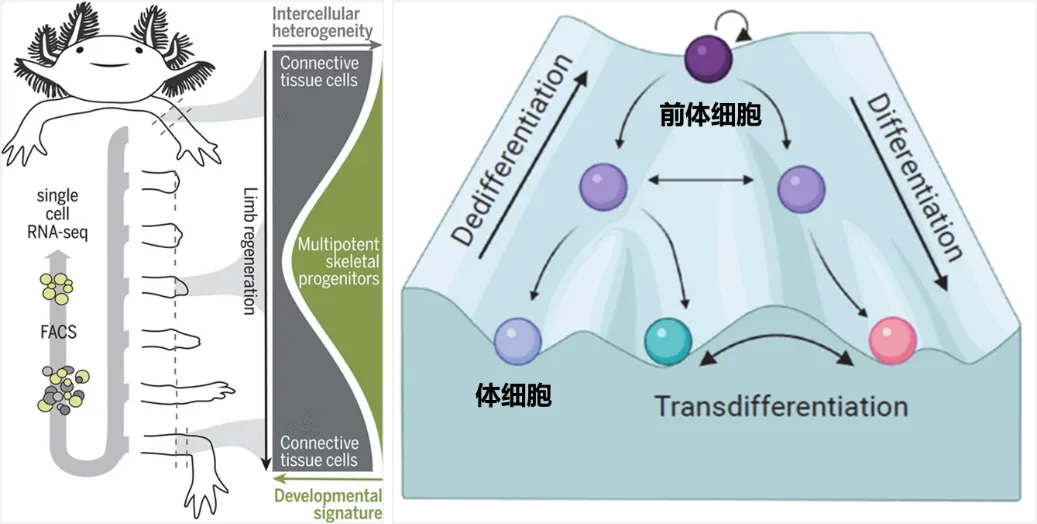
Left: Somatic cells dedifferentiate to produce precursor cells during the regeneration of severed limbs of salamander (Gerber et al., Science, 2018); right: Waddington model demonstrates the process of cell differentiation and dedifferentiation (Granados et al., Int. J. Mol. Sci. 2020)
In nature, some lower animals such as salamanders have shown amazing regenerative capabilities. Their limbs, hearts, brains and other important tissues and organs can achieve perfect regeneration and repair after damage. This magical ability is mainly attributed to the important potential of its somatic cells-dedifferentiation, that is, differentiated somatic cells can be stimulated by signals such as injury to reverse the development of rapidly proliferating embryonic-like precursor cells. state, thereby re-differentiating into functional cells and repairing damaged tissues and organs.
However, mammals, especially humans, have very limited regenerative capabilities due to the more stable fate of their somatic cells and reduced plasticity. After tissue and organ damage, it is difficult for human cells to effectively initiate the dedifferentiation process, which greatly limits the regeneration of damaged tissues or organs.
Therefore, how to simulate lower animals and effectively induce the dedifferentiation of human cells to regain precursor cells is one of the important scientific issues in stem cell and regenerative medicine research.
02 CiLBP cells
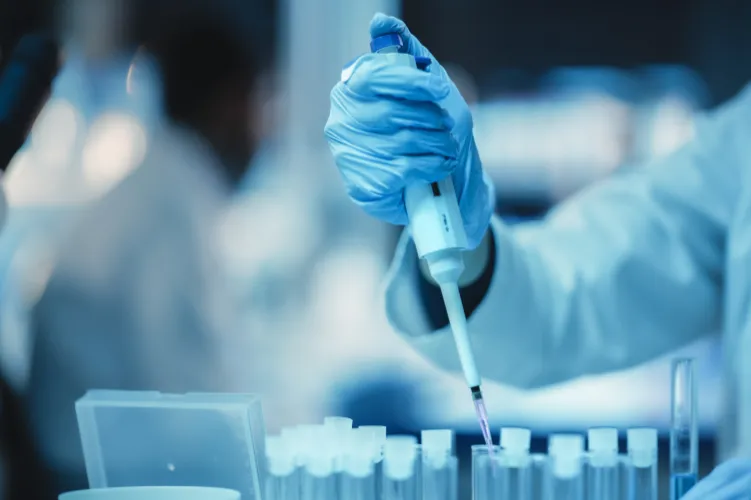
Small chemical molecules can induce somatic cells to dedifferentiate into human-like embryonic limb bud precursor cells (CiLBP cells)
In this study, Deng Hongkui's team confirmed that in the early stages of chemical reprogramming, small chemical molecules can induce somatic cells to dedifferentiate into human Chemically induced Limb Bud-like Progenitors (human CiLBP cells for short), and on this basis, conditions for long-term stable expansion of human CiLBP cells were established. Through single-cell transcriptome analysis, the research team found that the transcriptome of human CiLBP cells is similar to that of human embryonic limb bud cells. Dedifferentiation-related genes such as LIN28A and SALL4 were highly expressed in human CiLBP cells, while the expression of soma-related genes was reduced, indicating that soma-related characteristics were erased and a regeneration-related gene network was activated. Human CiLBP cells highly express genes related to limb bud development such as MSX1, HOXA9 and MEIS2, which is very similar to the state of limb bud cell groups after about 30 days of human embryonic development.
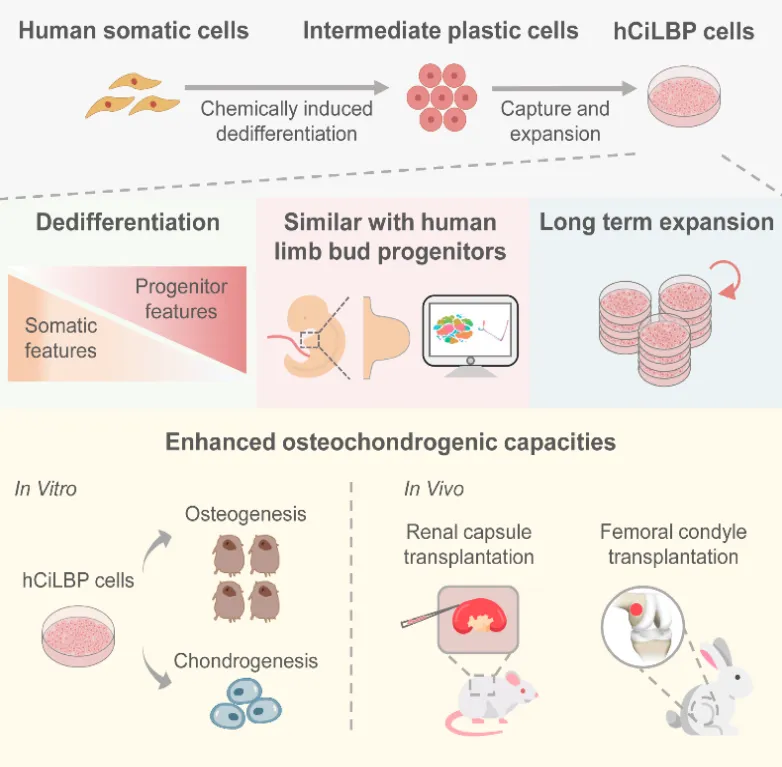
Chemical reprogramming technology induces somatic cells to dedifferentiate into limb bud precursor cells that can expand in large quantities and stably
Limb bud cells, as the progenitor cells of chondrocytes and bone cells, can eventually develop into limbs. Compared with parental somatic cells that have not undergone chemical reprogramming, human CiLBP cells have significantly improved chondrogenic and osteogenic capabilities. Under induction under chondrogenic conditions, cartilage-related genes can be highly expressed, related proteins can be secreted, and cartilage nodules can be formed. In vivo transplantation experiments have shown that human CiLBP cells can spontaneously differentiate to produce cartilage and bone-like cells in vivo, and promote bone damage repair in a rabbit femoral condyle defect model. Importantly, the initial human adipose stromal cells or human skin fibroblasts have limited expansion capabilities, while the induced human CiLBP cells can retain the characteristics of limb bud precursor cells and maintain good differentiation ability after up to 32 passages.
These characteristics prove that precursor cells obtained by chemical reprogramming induce dedifferentiation of somatic cells not only enhance differentiation ability, but also have the potential for large-scale expansion, providing new sources for their subsequent application in the treatment of bone and cartilage-related diseases. The source of cells has important clinical application value.
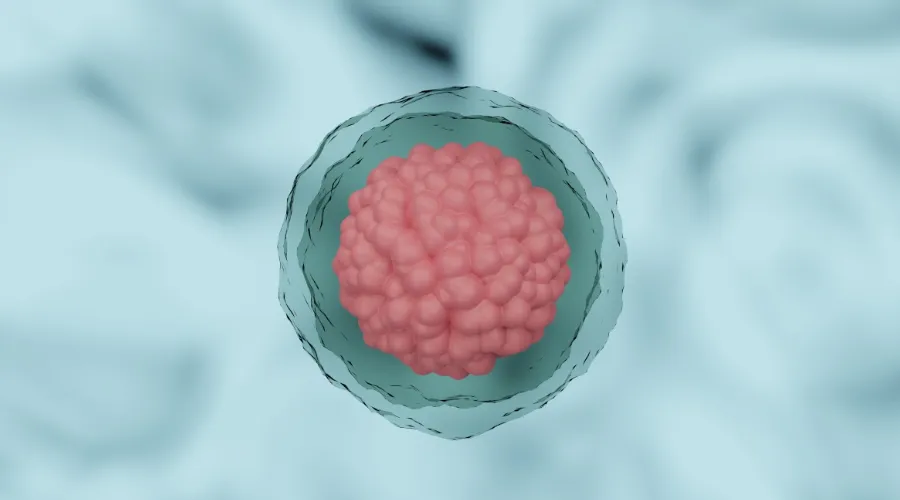
To sum up, Deng Hongkui's team used chemical reprogramming technology to accurately regulate cell fate in this study, successfully simulated the dedifferentiation process in lower animal tissue regeneration, and achieved the reversal of human cells from precursor cells. This achievement is of great significance.
(1)This study further proves that chemical reprogramming technology is different from traditional transgenic reprogramming technology. It can achieve controllable reversal of cell fate by regulating cell properties in an orderly manner, providing a new way to achieve dedifferentiation of human cells;(2) This study provides a new method for preparing large-scale expandable human precursor cells in vitro. The human precursor cells obtained by inducing dedifferentiation have stronger differentiation and proliferation capabilities, thus providing a more ideal source of cells for cell replacement therapy in damaged tissues and organs;
(3)Utilizing the unique advantages of chemical reprogramming to accurately induce dedifferentiation of human cells is expected to directly stimulate the regenerative potential of tissues and organs in the body, simulate the magical ability of lower animals in perfect regeneration and repair of tissues and organs, and provide new possibilities for the development of regenerative medicine.